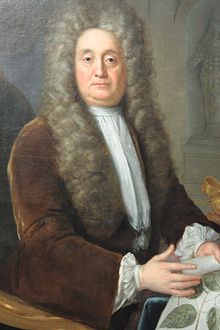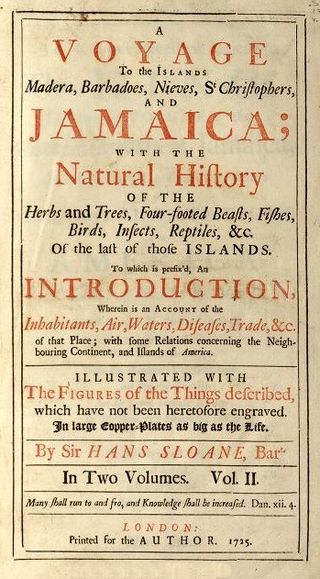Sir Hans Sloane was a major figure of 18th Century. He became a successful physician in London, with the Royal Family and other eminent persons as his patients, but he still found time to treat the poor for nothing. He made a large fortune and was able to pursue his lifelong interest in natural history, amassing a vast, important collection that was the foundation of the British Museum.

Sloane started his collection in 1687, when he accompanied the new Governor of Jamaica, the Duke of Albermarle, on a journey as his personal physician. Jamaica was fast emerging as a source of immense profit to British merchants, based on the cultivation of sugar and other crops by the forced labor of imported African slaves. Sloan collected some 800 species of plants and other live specimens to bring back to London. An account of his travels was published in 1707 and 1725.
However, Albemarle died in Jamaica the next year, so that Sloane’s visit lasted only fifteen months. During that time he noted about 800 new species of plants, which he cataloged in Latin in 1696; he later wrote of his visit in two lavishly illustrated folio volumes. He became secretary to the Royal Society in 1693 and edited the Philosophical Transactions of the Royal Society for twenty years.

Sloane married Elizabeth Langley Rose, the widow of Fulke Rose of Jamaica, and daughter of Alderman John Langley. Income from the sugar produced by enslaved African laborers on Elizabeth’s plantations at an area known as Sixteen Mile Walk fed the family fortunes in London and, together with Sloane’s medical revenue and London property investments, gave him the wealth to collect on a vast scale.
Sloane encountered cacao while he was in Jamaica, where the locals drank it mixed with water, though he is reported to have found it nauseating. Many recipes for mixing chocolate with spice, eggs, sugar, and milk were in circulation by the seventeenth century. After returning from Jamaica, Sloane may have devised his own recipe for mixing chocolate with milk.

By the 1750s, a Soho grocer named Nicholas Sanders claimed to be selling Sloane’s recipe as a medicinal elixir, perhaps making ‘Sir Hans Sloane’s Milk Chocolate’ the first brand-name milk chocolate. By the nineteenth century, the Cadbury Brothers sold tins of drinking chocolate whose trade cards also invoked Sloane’s recipe.

As for Slone’s collections, he absorbed complete collections made by others, among them William Charlton and James Petiver. He also received objects from friends and patients. As a result, his collection outgrew the house at No. 3 Bloomsbury Place, and he purchased No. 4 as well. Sloane’s house was visited by numerous people, among them was the composer Handel who is said to have outraged his host by placing a buttered muffin on one of his rare books.
